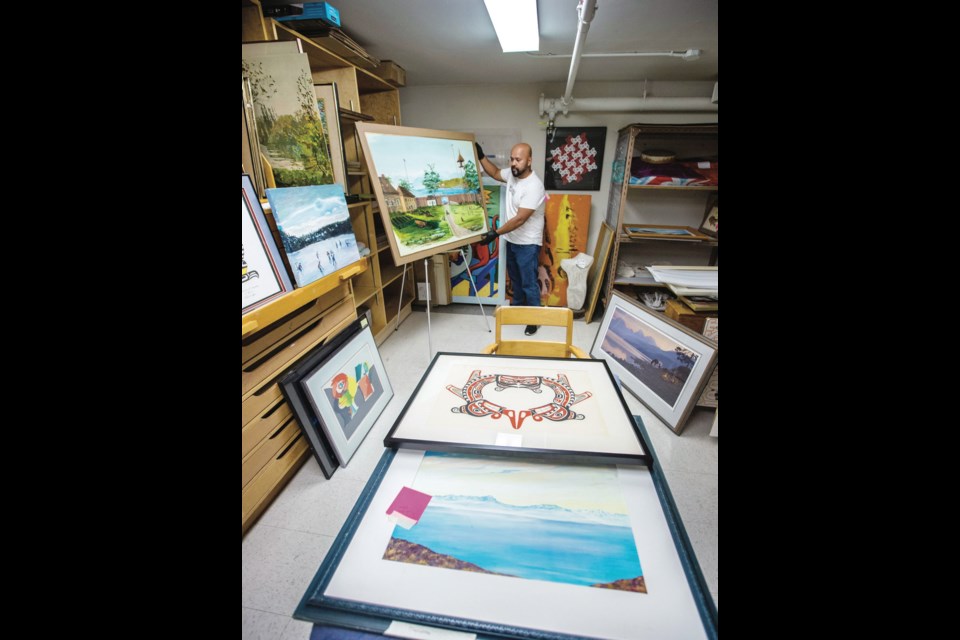Everything from valuable pieces of art worth up to $20,000 to dusty ledgers to age-tarnished trophies makes up the archives of the Greater Victoria school district, and efforts are underway to find the treasures a long-term home with public access.
District secretary-treasurer Mark Walsh, who has been part of a group doing an inventory of the art portion of the archives, said it is sometimes difficult to trace the precise history of items.
His office has become a repository for some of the key pieces, while much of the collection has recently been stored in a temporary location at the S.J. Willis Education Centre.
The move to S.J. Willis came about when space being used for storage at Central Middle School had to be reclaimed for use as a classroom. As in other schools around the district, more classroom space was needed to comply with last fall’s Supreme Court of Canada decision restoring B.C. teachers’ 2002 contract language on class size and composition.
The complete collection is considered “a vital but underused district educational resource,” Walsh wrote in a report to the school board. He credited volunteers Judi Stevenson and Wayne Bembridge with doing the bulk of the archival work.
Stevenson, a former principal in the district, said it took about a dozen moving trucks to transport the archival material from Central to S.J. Willis, and there are still 320 boxes to sort through.
“We’re going to do a little culling of the collection and a little bit of renumbering and that sort of thing, in hopes that we’ll find a permanent location.”
She said moving around has been a fact of life for the archives.
“We’ve sort of been a bit of a bouncing ball in the district,” Stevenson said. “For many years we’ve been a well-kept secret, as well.”
She said that is changing a little as more people hear about the archives, with many of them inspired to make donations.
Stevenson said the portion of the archives at S.J. Willis includes school pictures, staff pictures and assorted material from schools that have closed over the years. That part of the archives also included a pair of donated pianos at one point, but Stevenson was able to find them a home.
Stevenson, a history buff with a degree in fine art, has been working on the archives for close to 15 years.
“I’m a Virgo, I like to organize things,” she said laughing.
The archives have been added to in a number of ways over time, Walsh said, including by artists who also happen to have worked in the district and want to donate their creations.
“Or an artist has been an artist-in-residence like Ted Harrison, like Robert Amos,” Walsh said. “Sometimes a purchase is in honour of a principal or a graduation class.”
In one instance, a parent group decided in the 1950s to buy a painting by Canadian artist David Milne and donate it for students to enjoy, he said. Its current value is estimated at $20,000.
Also prominent in the collection is a painting by Fenwick Lansdowne, a former student in the district, that is also valued at $20,000. Another piece is by Arthur Lismer, a member of the Group of Seven.
Still another special piece of art is a self-portrait by Carole Sabiston, who was a teacher at Oak Bay High School before going on to international fame as an artist. She was a member of the local art group known as the Limners. “She’s been quite connected to the district throughout her life,” Walsh said.
He said it was hard to know the scope of what the district had before a recently completed inventory of archived art, which is made up of about 1,100 pieces. Some previous updating of the art collection had been done in 2005-07, but the last complete inventory was in 1983.
The overall size and value of the archives is unknown, but it contains “thousands and thousands” of items, Walsh said.
The Greater Victoria district was created in 1946 through an amalgamation of Esquimalt, Oak Bay, southern Saanich, Victoria and what is now View Royal but the archives include material going back decades earlier.
Finding a home for the archives could involve various scenarios. Perhaps there could be space found at a private gallery, Walsh said, or maybe room could be created during an upgrade of a district school. “The challenge is to make sure that things are safe and secure.”
Some valuable items have disappeared over time, including artwork by Jack Shadbolt, Roy Henry Vickers and Grant Leier, he explained.
Art also has to be in an area that prevents damage, such as fading, Walsh said. There can also be a need for reframing or other improvements, but there is not a lot of money available.
“Does that mean loaning it out in exchange for upgrading the preservation quality of the piece?”
Walsh credited the inventory process with giving him the basic knowledge to collect art himself, an interest that has filled a wall of his office with creations by local artists.



